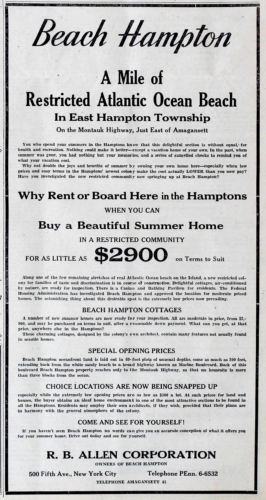Beach Hampton: 'A New World Of Happiness'

Romance? Glamour? Scenic Beauty? Recreation? Historic Memories? Beach Hampton is indeed in the heart of Wonderland…. How this mile of pure, white sands, blue waters and silvery surf does sing to the soul!

More obscure than Carl Fisher’s developments in Montauk, yet also still significant today, is the community of Beach Hampton, though it’s now usually known as the Amagansett Dunes. Less grandiose than Fisher’s scheme, Beach Hampton was planned for the more modest years of the Depression.
In April 1936, the New York Times announced that Richard B. Allen’s corporation had purchased 234 acres to the east of Amagansett, between the ocean beach and Bluff Road and Montauk Highway, bounded west and east by Beach and Napeague Lanes. The new development was to be called Beach Hampton.



The company published a promotional brochure, Eastward to the Sea: The Romance of Beach Hampton, in which prospective buyers could learn about the benefits of a summer house. “Romance? Glamour? Scenic Beauty? Recreation? Historic Memories? Beach Hampton is indeed in the heart of Wonderland…. How this mile of pure, white sands, blue waters and silvery surf does sing to the soul!” The twenty-five-page brochure included drawings of various styles of houses that could be purchased from the company for as little as $2,900. “Beach Hampton, less than three hours from New York City, is not just another real estate development, it is an ideal, a vision, a dream that we have made come true. Here, if you will, awaits you, a new world of happiness!”
The first houses, “air conditioned by nature,” were finished in 1937. In 1938, the Beach Hampton Surf Club opened with gala celebrations in August.

Then disaster struck. On September 21, 1938, the devastating hurricane known as the Long Island Express roared in and destroyed most of the buildings. But with many of the lots sold and the streets laid out, houses were rebuilt. (Many of the streets were still unpaved. Allen asked East Hampton to pave the streets, but the town declined. To this day, many of them are still dirt.)
Between 1941 and 1965, many of the small houses built in the area were designed by Albert Scheffer. Sometimes known as the dean of East Hampton architects, Scheffer specialized in building small, cozy beach houses that were so close to the ocean, they didn’t need pools. With casual layouts for beach living, the houses sported exposed beams, fireplaces, and natural weathered brick or knotty pine interiors.
Today most of the Scheffer cottages have been demolished or remodeled beyond recognition, although there are a few originals left on Sandpiper Lane, throwbacks to a simpler time in Hamptons real estate.



